Ventilation systems: the main classification, principle of
From this article you will learn how the ventilation systems in medical institutions and their domestic counterparts are arranged. In addition, we consider the classification of the systems responsible for indoor air exchange and which type is preferred for use in certain conditions.
The history of operation of more or less effective ventilation schemes is a centuries-old time span. After all, even the ancient Romans had the idea that fresh air in enclosed spaces can be obtained in the required amount.
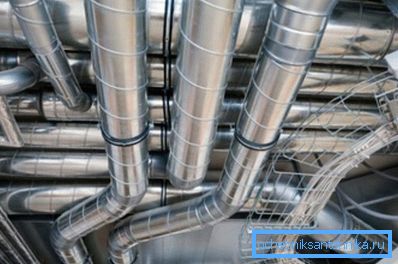
Much time has passed since then, and technologies have evolved, become more complex and more effective. As a result, there are many solutions on the market, based on different principles of action and characterized by different parameters.
What, and based on what considerations, to choose from the range of proposed technologies?
The need for effective and efficient ventilation

Before deciding which equipment for ventilation systems is relevant in a particular case, consider the principle of how air exchange is built in closed rooms and what is the need for these processes.
The operation manual of the most part of the air exchange schemes is based on the displacement of the exhausted air volume with a fresh volume.
The action of some systems is based on the difference in air pressure inside and outside the building. Other circuits operate with fans that draw exhaust air to the outside, while fresh air is supplied to the outside for replacement. Both the one and the other scheme can be implemented with their own hands in the house or in the apartment.
So, we have decided on the principle of action, and now we will decide how necessary ventilation of enclosed spaces is and what advantages it provides.

During the operation of certain premises, there is an excessive level of heat and moisture in the air in combination with a small amount of oxygen. In addition, in the exhaust air there is an excess concentration of carbon dioxide and other invisible pollutants. Another important type of pollution is dust, which accumulates indoors and implies the need for timely removal.
Almost all types of ventilation systems known today are designed to remove harmful impurities and to improve air quality. In addition, the use of ventilation is designed to provide optimal sanitary and hygienic conditions, including acceptable temperature, humidity and traffic flow.
Important: High-quality air exchange in the room is ensured by regular maintenance of ventilation systems.
The main classification of ventilation devices

The norms of air exchange intensity are governed by sanitary rules and regulations (San Pin) and construction rules and regulations (SNiP).
When designing a ventilation system, the following parameters are taken into account:
- performance (movement of air at the rate of m? / h);
- duct flow rate (m / s)
- working pressure (Pa);
- heater power (kW);
- maximum noise level (dB).
Modern classification of ventilation systems involves the division into types in accordance with the following criteria:
- in accordance with the method of moving air flows - the ventilation of the natural (passive) and forced (mechanical) type is different;
- in accordance with the method of organization - supply and exhaust;
- based on the features of the design - channelless and channel;
- in accordance with the purpose - local, general exchange, emergency and smoke.
Design and production of ventilation systems is based on the amount of air per person per hour. For example, with regard to the parameters of an air-raid shelter, the air consumption per person is about 2.5 cubic meters per hour, whereas in an office room, these parameters increase to 20 m ?.
Consider these modifications of ventilation systems in more detail.
Natural and forced ventilation scheme
As already mentioned, modern ventilation systems are divided into natural and forced modification.
What is the difference and what is more suitable for arranging those or other indoor premises?
- Natural ventilation works due to the difference in pressure inside and outside the object.. The exhaust air is discharged through the hood, while the inflow is carried out through special inlet pipes or through leaks in the porch of windows and doors.
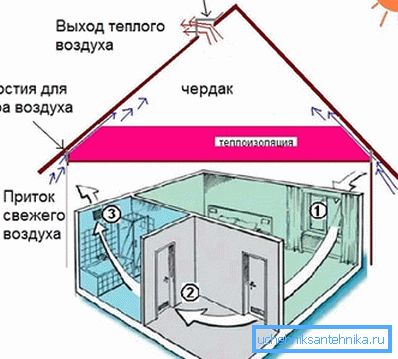
Systems of the natural (passive) type, in turn, are subdivided into the following modifications:
- Organized ventilation - involves the device air exchange through specially prepared intake and exhaust openings. Such a system allows not only to replace the exhaust air with the supply air, but also to adjust the intensity of the flow.
- Unorganized ventilation presupposes the presence of a hood without a supply air duct (its function will be performed by an open vent or gaps in the vestibule of windows and doors).
- Mechanical (forced) ventilation involves the movement of air by creating a pressure difference using fans or ejectors.
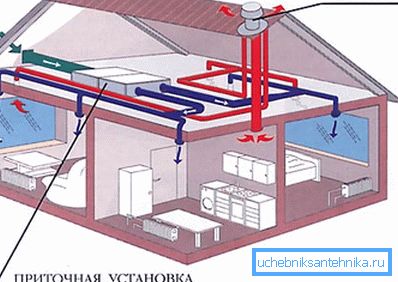
The scheme is more efficient in comparison with the passive variety, since it works regardless of the climatic conditions outside the building.
Important: Due to the use of special electronic devices, dispatching of ventilation systems and automated control in combination with effective control of the basic parameters of air exchange in the room become possible.
Classification of systems by type of organization of air exchange
- Local ventilation - This is a supply air scheme in which air is supplied to specific areas of the room, while exhaust air from these areas is removed. A typical example of such a scheme for the implementation of air exchange is a kitchen hood installed above the stove.
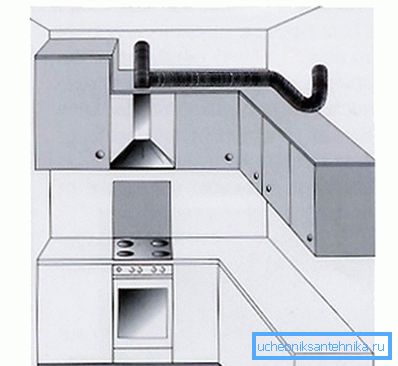
In addition to domestic use, such a scheme has found wide application in the ventilation of industrial premises where it is necessary to remove polluted air from one or another production site.
- General exchange type ventilation it is intended for equally effective maintenance of air exchange parameters throughout the whole room, regardless of its parameters.
Such schemes are most often used in the arrangement of office space and retail space.
- Anti-smoke systems installed in the framework of fire safety in the room.
Smoke removal systems in case of unauthorized ignition bring out the products of combustion, allowing people in the room to evacuate and evacuate valuable property that may be damaged in a fire.
- Emergency Ventilation Systems used in areas where there is an increased likelihood of an unexpected release of harmful or potentially hazardous substances in volumes exceeding the MPC standards.
Emergency ventilation is characterized by increased performance and allows you to remove excess gas in the shortest possible time. Installations of this type are installed and operated exclusively at industrial facilities.
Equipment used in ventilation systems
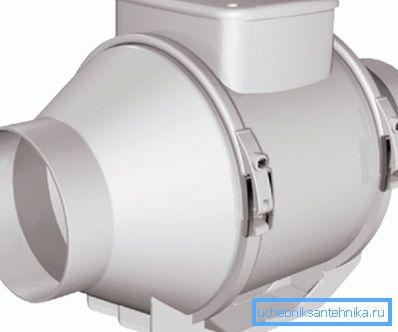
Equipment and accessories for ventilation systems on the market are represented by a wide range of devices, among which we note the following categories:
Fans - mechanical blade-type devices that force air into the ventilation ducts.
In accordance with the design and operational features, the fans are divided into the following modifications:
- channel (rectangular and round);
- diametrical (tangential);
- axial (axial);
- radial (centrifugal);
- roof.
Consider the main types of these devices as detailed as possible:
- Axial, or as they are called axial fans, have found application in the simplest household hoods.
Such devices are distinguished by a low price. The design is an external casing, inside which is located an electric motor and an impeller, which drives the air. Despite the simplicity of the design, fans of this type have a higher efficiency in comparison with analogues, arranged differently.
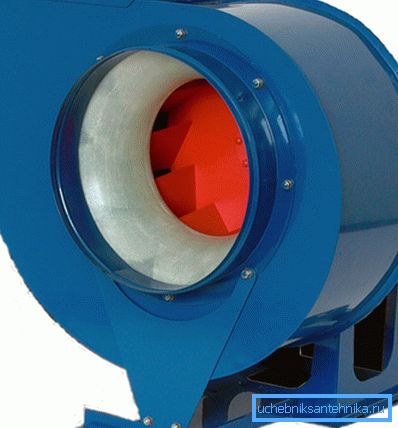
- Radial (centrifugal) fans are widely used in the construction of industrial systems. These devices are characterized by reliability and as a result a long resource.
The design of the device is a spiral casing and a propeller located in it, rotating around its axis. The screw spins the air flow, which is thrown into the duct under the action of centrifugal force.
- Tangential (diametrical) fans are another kind of industrial installations. The device looks like a closed design with connections for air inlet and outlet. Such installations are mounted in air conditioning systems and heat curtains. Less commonly, the unit is installed in the duct rupture.
In addition to blowers, the following structural elements are used in ventilation systems:
- Air ducts - pipes with a rectangular or round cross-section, connected in a single structure by means of taps and special mounting accessories.
- Profiles for ventilation systems - are metal guides with mounting perforations on which all components are mounted.
- Sound attenuators and sound insulation materials - used to reduce noise levels during operation of the system.
- Filters for ventilation systems are a wide range of devices that are installed on the inlet duct and prevent dust and other contaminants from entering the room.
- Air heaters - can be used in ventilation systems and completely replace the heating. Along with conventional heaters, recuperators are increasingly used in ventilation, making it possible to reduce the cost of heating air by reducing power consumption.
Conclusion
So, we have considered the features of the device ventilation systems. Moreover, we found out what equipment is used in the implementation of certain schemes. This information can be applied in practice, for example, when arranging ventilation in a country house.
Have any questions? You will find more useful information by watching the video in this article.